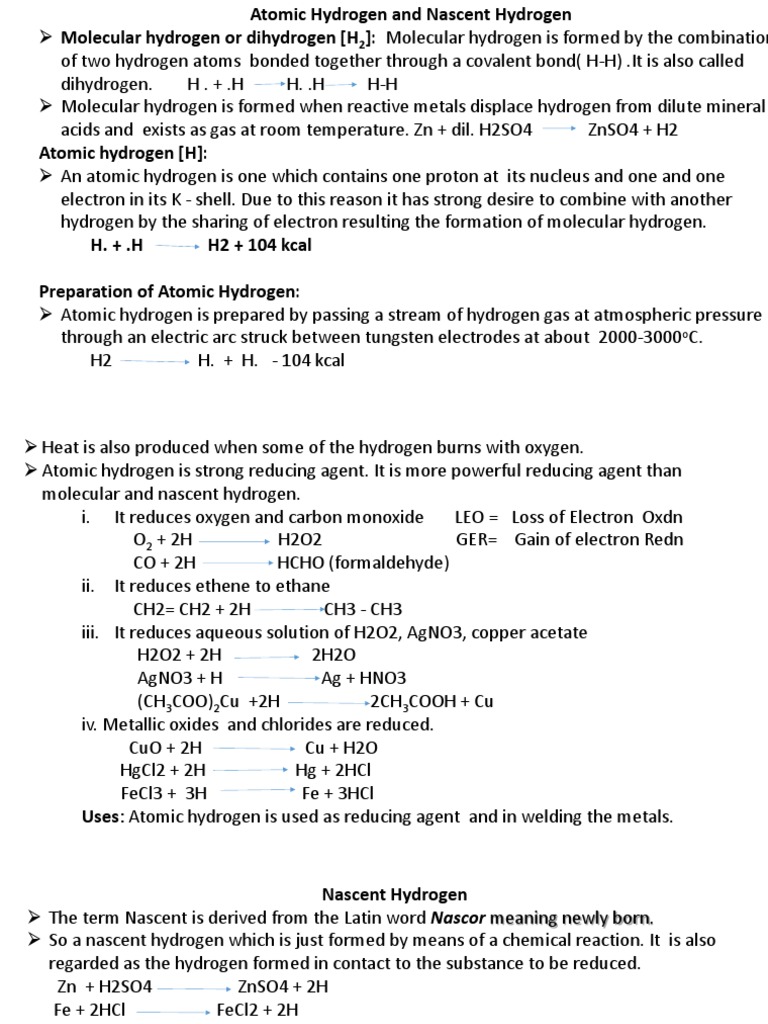Hydrogen, the simplest and most abundant element in the universe, exists in various forms, including atomic and nascent hydrogen. Each of these forms presents unique chemical properties and reactivities, priming them for different applications in scientific research and industrial processes. Understanding the disparities in reactivity between atomic and nascent hydrogen is essential for chemists and physicists alike, as it not only unveils fundamental characteristics of hydrogen itself but also unlocks potential innovations across multiple fields.
To embark on this exploration, it is imperative to define atomic hydrogen and nascent hydrogen distinctively. Atomic hydrogen refers to isolated hydrogen atoms that have been dissociated from diatomic molecules (H2). This form is unbound and possesses significant energy, making it capable of engaging in various chemical reactions. Nascent hydrogen, however, is more elusive, typically generated during chemical reactions under specific conditions. It exists in a highly reactive state, often more so than its atomic counterpart, due to its enthalpy and the transient conditions under which it is produced.
The reactivity of substances is primarily governed by their electronic structure. In the case of atomic hydrogen, each hydrogen atom has a single electron in its outer shell, which it is eager to share or exchange to achieve a more stable electronic configuration. As a result, atomic hydrogen is inherently reactive, willing to form bonds with other atoms in the pursuit of stability. Yet, nascent hydrogen exhibits even greater reactivity. The process that produces nascent hydrogen often generates free radicals, which are highly reactive species with unpaired electrons. This radical nature facilitates the immediate formation of new bonds, thus enhancing the overall reactivity of nascent hydrogen.
Explorations into the mechanisms of hydrogen reactivity demonstrate that the configurations of atoms and molecules play crucial roles. In atomic hydrogen, the absence of surrounding molecular structure allows it to engage with various substrates, yet it may combine slower than nascent hydrogen, which emerges from laboratory reactions like electrolysis or catalytic decomposition. In these situations, nascent hydrogen readily interacts with other substances—exhibiting extraordinary speed in its ability to react due to its unstable nature and high-energy condition.
Consider the implications of reactivity within biochemical contexts. Many enzymes utilize hydrogen in the form of nascent hydrogen during catalysis, reflecting its heightened reactivity. For example, in hydrogenation reactions, nascent hydrogen can add across double bonds in organic compounds, often occurring more efficiently than atomic hydrogen can intervene. In such scenarios, nascent hydrogen effectively alters the molecular architecture, providing an invaluable tool for synthetic chemistry. The understanding that nascent hydrogen acts with a vigorous efficiency enhances the precision with which chemical transformations can be executed, fueling advancements in organic synthesis.
Further complicating the narrative of hydrogen’s reactivity are the physical states in which atomic and nascent hydrogen can exist. When considering atomic hydrogen in gaseous form versus the reactive potential of nascent hydrogen generated under specific reaction conditions, each plays a crucial role in determining reaction rates and pathways. In industrial applications, for instance, the transition from atomic to nascent hydrogen can markedly alter the efficiency of hydrogenation or dehydrogenation processes.
Let us also examine the temporal dimension of reactivity. While atomic hydrogen exists notably in a stable state, nascent hydrogen’s reactivity may diminish quickly post-synthesis due to its immediate propensity for reaction with surrounding substances. Thus, the fleeting nature of nascent hydrogen underscores the necessity for precision timing when deploying this form in chemical processes. This characteristic can pose both a challenge and an opportunity for chemists, as harnessing nascent hydrogen effectively requires acute awareness of reaction kinetics and environmental conditions.
In terms of safety considerations, it is paramount to acknowledge the inherent risks associated with both atomic and nascent hydrogen. The explosive nature of hydrogen gas can be exacerbated when transitioning from atomic to nascent forms, particularly in confined environments where concentrations can escalate. Therefore, understanding the reactivity profile of these forms of hydrogen is crucial not only in optimizing their use but also in mitigating potential hazards during experimental and industrial operations.
Ultimately, the inquiry into which is more reactive, atomic or nascent hydrogen, reveals a nuanced landscape. While atomic hydrogen is undeniably reactive, nascent hydrogen often outpaces it due to its radical nature and the unique conditions under which it is formed. This enhanced reactivity not only elevates its utility in chemical synthesis but also invites ongoing research into the dynamic behaviors of hydrogen across various disciplines.
In conclusion, the distinction between atomic and nascent hydrogen transcends mere nomenclature; it encapsulates broader themes of stability, reactivity, and application potential. As the scientific community continues to unravel the complexities of hydrogen’s behavior, the intrigue surrounding these two forms promises not only to shift existing paradigms but to inspire innovative approaches to harnessing one of nature’s simplest yet fundamentally significant elements.












